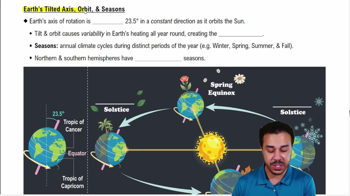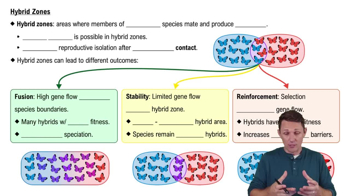Table of contents
- 1. Introduction to Biology2h 40m
- 2. Chemistry3h 40m
- 3. Water1h 26m
- 4. Biomolecules2h 23m
- 5. Cell Components2h 26m
- 6. The Membrane2h 31m
- 7. Energy and Metabolism2h 0m
- 8. Respiration2h 40m
- 9. Photosynthesis2h 49m
- 10. Cell Signaling59m
- 11. Cell Division2h 47m
- 12. Meiosis2h 0m
- 13. Mendelian Genetics4h 44m
- Introduction to Mendel's Experiments7m
- Genotype vs. Phenotype17m
- Punnett Squares13m
- Mendel's Experiments26m
- Mendel's Laws18m
- Monohybrid Crosses19m
- Test Crosses14m
- Dihybrid Crosses20m
- Punnett Square Probability26m
- Incomplete Dominance vs. Codominance20m
- Epistasis7m
- Non-Mendelian Genetics12m
- Pedigrees6m
- Autosomal Inheritance21m
- Sex-Linked Inheritance43m
- X-Inactivation9m
- 14. DNA Synthesis2h 27m
- 15. Gene Expression3h 20m
- 16. Regulation of Expression3h 31m
- Introduction to Regulation of Gene Expression13m
- Prokaryotic Gene Regulation via Operons27m
- The Lac Operon21m
- Glucose's Impact on Lac Operon25m
- The Trp Operon20m
- Review of the Lac Operon & Trp Operon11m
- Introduction to Eukaryotic Gene Regulation9m
- Eukaryotic Chromatin Modifications16m
- Eukaryotic Transcriptional Control22m
- Eukaryotic Post-Transcriptional Regulation28m
- Eukaryotic Post-Translational Regulation13m
- 17. Viruses37m
- 18. Biotechnology2h 58m
- 19. Genomics17m
- 20. Development1h 5m
- 21. Evolution3h 1m
- 22. Evolution of Populations3h 52m
- 23. Speciation1h 37m
- 24. History of Life on Earth2h 6m
- 25. Phylogeny2h 31m
- 26. Prokaryotes4h 59m
- 27. Protists1h 12m
- 28. Plants1h 22m
- 29. Fungi36m
- 30. Overview of Animals34m
- 31. Invertebrates1h 2m
- 32. Vertebrates50m
- 33. Plant Anatomy1h 3m
- 34. Vascular Plant Transport2m
- 35. Soil37m
- 36. Plant Reproduction47m
- 37. Plant Sensation and Response1h 9m
- 38. Animal Form and Function1h 19m
- 39. Digestive System10m
- 40. Circulatory System1h 57m
- 41. Immune System1h 12m
- 42. Osmoregulation and Excretion50m
- 43. Endocrine System4m
- 44. Animal Reproduction2m
- 45. Nervous System55m
- 46. Sensory Systems46m
- 47. Muscle Systems23m
- 48. Ecology3h 11m
- Introduction to Ecology20m
- Biogeography14m
- Earth's Climate Patterns50m
- Introduction to Terrestrial Biomes10m
- Terrestrial Biomes: Near Equator13m
- Terrestrial Biomes: Temperate Regions10m
- Terrestrial Biomes: Northern Regions15m
- Introduction to Aquatic Biomes27m
- Freshwater Aquatic Biomes14m
- Marine Aquatic Biomes13m
- 49. Animal Behavior28m
- 50. Population Ecology3h 41m
- Introduction to Population Ecology28m
- Population Sampling Methods23m
- Life History12m
- Population Demography17m
- Factors Limiting Population Growth14m
- Introduction to Population Growth Models22m
- Linear Population Growth6m
- Exponential Population Growth29m
- Logistic Population Growth32m
- r/K Selection10m
- The Human Population22m
- 51. Community Ecology2h 46m
- Introduction to Community Ecology2m
- Introduction to Community Interactions9m
- Community Interactions: Competition (-/-)38m
- Community Interactions: Exploitation (+/-)23m
- Community Interactions: Mutualism (+/+) & Commensalism (+/0)9m
- Community Structure35m
- Community Dynamics26m
- Geographic Impact on Communities21m
- 52. Ecosystems2h 36m
- 53. Conservation Biology24m
48. Ecology
Introduction to Ecology
Problem 1`
Textbook Question
Explain why the northern United States experiences a cold season in winter and a warm season in summer.
 Verified step by step guidance
Verified step by step guidance1
Understand the Earth's tilt: Recognize that the Earth is tilted on its axis by approximately 23.5 degrees. This tilt is crucial in creating the seasons as it affects the amount of sunlight different parts of the Earth receive throughout the year.
Consider the Earth's orbit: Know that as the Earth orbits the Sun, the orientation of the tilt relative to the Sun changes. This means that during different times of the year, different parts of the Earth receive more direct sunlight and for longer periods of the day.
Analyze winter conditions: In the northern United States during winter, the northern hemisphere is tilted away from the Sun. This results in shorter days and the Sun being lower in the sky, which reduces the intensity and duration of sunlight, leading to colder temperatures.
Examine summer conditions: Conversely, during the summer, the northern hemisphere is tilted towards the Sun. This results in longer days and the Sun being higher in the sky, which increases the intensity and duration of sunlight, leading to warmer temperatures.
Relate tilt to seasonal changes: Summarize how the tilt of the Earth, combined with its orbit, leads to significant changes in sunlight exposure for the northern United States, thus explaining the distinct cold season in winter and warm season in summer.
 Verified video answer for a similar problem:
Verified video answer for a similar problem:This video solution was recommended by our tutors as helpful for the problem above
Video duration:
47sPlay a video:
Was this helpful?
Key Concepts
Here are the essential concepts you must grasp in order to answer the question correctly.
Earth's Tilt and Seasons
The tilt of the Earth's axis, approximately 23.5 degrees, is the primary reason for the changing seasons. During winter in the northern United States, the North Pole is tilted away from the sun, resulting in shorter days and less direct sunlight, leading to colder temperatures. Conversely, in summer, the North Pole tilts towards the sun, increasing sunlight exposure and warmth.
Recommended video:
Guided course

Earth’s Tilted Axis, Orbit, & Seasons
Solar Radiation
Solar radiation refers to the energy emitted by the sun, which varies in intensity based on the angle of sunlight striking the Earth. In winter, the sun's rays hit the northern United States at a more oblique angle, spreading the energy over a larger area and reducing warmth. In summer, the rays strike more directly, concentrating energy and raising temperatures.
Recommended video:

Adaptive Radiation
Climate Zones
The northern United States falls within temperate climate zones, characterized by distinct seasonal changes. These zones experience significant temperature variations between summer and winter due to the Earth's axial tilt and solar radiation patterns. This results in cold winters with snowfall and warm summers, influencing local ecosystems and human activities.
Recommended video:

Hybrid Zones
Related Videos
Related Practice

































































































